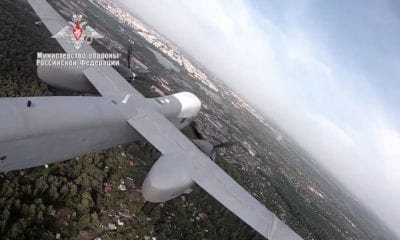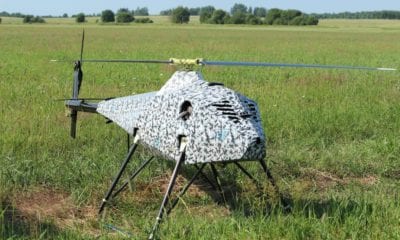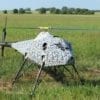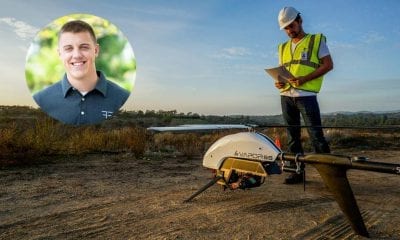
Back to Base (B2B)
Drone Counteraction in Modern Warfare, Interview with Aliaksei Stratsilatau, UAVOS Co-founder
The fact that drones/UAV are being increasingly developed and used for military means cannot be ignored. A recent report on the global military drone market describes a range of commercial technology used in unmanned aerial systems including power sources, propulsion systems, autonomous systems, object avoidance systems, communication links, data processing and streaming as well as cyber security and jamming. We talked to Lead Developer Aliaksei Stratsilatau of Silicon Valley- based company UAVOS about how they are considering this last factor.
Thanks for your time Aliaksei. Please describe current means of UAV counteraction in modern warfare.
At the present time, the main and most effective means of combating small-sized UAVs equipped with MEMS-based avionics (micro electromechanical systems) of gyroscopes and accelerometers that are characterized by low cost and miniaturized dimensions, in contrast to high-precision fiber-optic PINS (platformless inertial navigation system), is by using jamming countermeasures on the GNSS (Global Navigation Satellite System).
What are the inherent difficulties associated with using GNSS to counteract UAVs?
Ordinarily, the vast majority of such small-sized UAVs after the loss of the GNSS signal lose orientation and fall, or make a forced parachute landing or automatic landing – as in case with multi-rotor UAV systems.
More advanced and more expensive models of UAVs can operate by being controlled with a command line using video transmission from a board or a complex system of on-board sensors and a magnetometer (compass) to exit from the jamming zone. The use of a video camera on board the UAV and on-board video processing computer for land navigation by video image does not solve the problem of flying in difficult weather conditions at night and, therefore, is applicable rather conditionally.
Are there other methods of counteracting military drones without the use of GNSS? How are these methods addressed by the manufacturers of military drones?
In order to counteract the above-described technologies used in UAVs in addition to interfering with the GNSS there is also used the method of jamming communications in the command line and payload communications. Of course, the PROFR (pseudorandom operational frequency readjustment) used in modern modems complicates the process of jamming, but modern means of electronic warfare (EW) cope with this task, since modems on small-sized UAVs have low power and simple frequency control algorithms. It should be noted that in most cases the area on which the interference is made by means of EW is not vast – no more than 30 km.
Therefore at the present moment, to effectively carry out the task of fulfilling the mission and just flying in the conditions of EW, only few small-sized (up to 50 kg) UAVs may be deployed at a time. Such UAVs use either fiber-optic PINS or combinatorial computing algorithms of on-board sensors to correct the readings of on-board accelerometers and MEMS gyroscopes. This type of UAV is practically invulnerable to classical EW and can quite steadily perform the task of recording reconnaissance data on storage devices for a sufficiently long time. For example, the error in calculating the coordinates of such systems can be in the range of 1-5 km per flight hour. To correct its coordinates, the UAV can leave the interference zone and temporarily turn on the GNSS.
How do they do this, and is it possible to recognise the methods being used in deployed unmanned aircraft?
A special place in EW systems is occupied by modern systems that substitute false coordinates (data) for the on-board control system. But even here there are a lot of signs by which it is possible to determine such interference as, for example, the coordinates jump, the disconnection of all satellites and the subsequent inclusion of only a small group of false ones, for example, 6 of 28 of those received earlier, etc. In this case the system must recognize the attempt of setting false signals and disconnect from the use in navigation of the GNSS data to a guaranteed departure from the interference area.

Where do you foresee cyber-jamming technology heading?
I’ve never experienced the use of electromagnetic systems and other methods such as disabling the modern autopilots on the complex principles of data processing of on-board sensors or fiber optic PINS, and I think that in the near future that’s highly improbable in view of the sufficiently large distances to the UAV from the emitting source. Naturally, it’s true only for professional systems that are immune to electromagnetic interference to on-board wiring and with the correct topology of the on-board network.
UAVOS are working to enhance their research and development efforts having recently raised funding through a group of private investors. They also demonstrated their new multi-purpose ‘tractor’ drone at the Unmanned Systems Exhibition and Conference (UMEX) in Abu Dhabi last week. This is an unmanned UVH-290E helicopter with a gasoline rotary engine, and is the newest modification of UAVOS helicopters.

About Aliaksei Stratsilatau
Aliaksei Stratsilatau is UAVOS Cofounder and Сhairman of the board. He’s been fascinated in robotics since a very young age. In his school years he participated in city-level science
competitions among high-school students. He studied Computer and Information Science at the Department of Radioecology at the International Environmental Sakharov University (Belarus). His B.S. thesis was Efficiency computation of solar power cells based on non-linear computer modeling.
After graduation, Aliaksei worked for an international companies where at different times he was responsible for the electronics and software, detail design and design substantiation of new UAV systems; was a Head of R&D department. Currently he conducts researches in the field of Robotics and Unmanned Aerial Systems (UAS), leading to creation of affordable unmanned vehicles for civil applications and increasing human capacity.
























